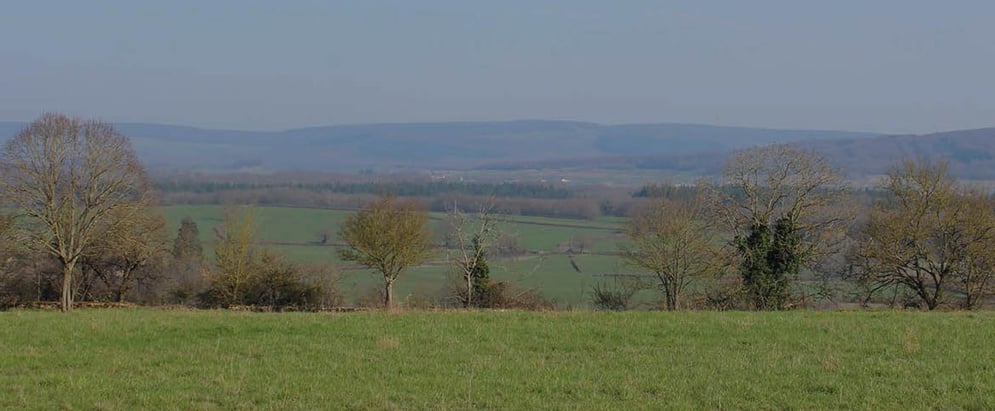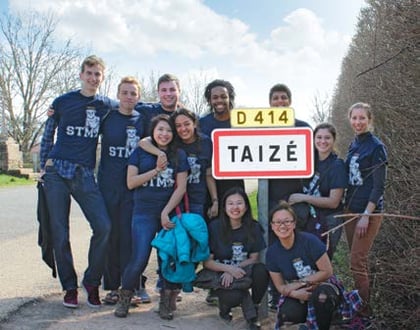
It is so wondrous to have a song stuck in your head. The melody automatically plays on loop, refusing to cease for even a second to allow the intervention of lunchtime chatter. You know exactly how the chant ends, and exactly how to subtly connect the last syllable with the first as the song repeats itself. You recognize that familiar calmness, that glowing feeling, as the chant slowly takes root and grows inside you. It takes a while for you to notice that you’re now singing “Bénissez le Seigneur” out loud in the Trumbull Dining Hall! You’re back at Yale, and people are staring.
The Alternative Spring Break trip to Taizé from March 12 to 19 is at its core a pilgrimage of spiritual healing and personal discovery. As the inaugural STM Spring Break group to Taizé, the twelve of us—eleven students and Assistant Chaplain Carlene Demiany ‘12 M.Div.—left for France after a stressful week of examinations at Yale. In the ecumenical, international monastery in Burgundy, we prayed, chanted, observed silence with the brothers three times a day, discussed Bible readings with the most interesting people, squeegeed the kitchen floor and indulged in simple meals of soup and bread (and sometimes, pasta). Every morning, we woke up to the slightly annoying screeching of birds. Every night, we tucked ourselves in with remnants of Taizé chants looping through our heads. Some nights, we lit candles and praised God through song until 1 a.m., our voices sore and soaring through the quiet countryside. We talked about brokenness, about love, about good chocolate, about bad artwork and about the stars, finding in all of our conversations the face of God.
Taizé represents an indescribable feeling I will carry with me forever, especially at times of stress and sadness. Whenever I feel distant from God’s love, I will trace the edges of the Taizé cross, shaped like a dove, resting on my collarbone. I will meet up with the amazing people who shared this experience with me, laughing over nothing and reveling in shared silence. I will gladly welcome into my head the melody of Taizé chants, especially during lunchtime, regardless of my classmates’ staring. In these experiences, I find the magic of Taizé — that in community and in silence, I can viscerally feel the normallyabstract concepts of peace, of kindness, of reconciliation, of healing. I hope that this feeling never leaves me.
The Taizé Community, founded by Brother Roger Schütz in 1940, is an ecumenical monastic order in Taizé, France. The community is one of the world’s most important sites for pilgrimage and its ministries focus on youth, worship and music. Below is an example of a Taizé chant. It is simple in melody and structure, contains Biblical allusions and can be sung in many languages—French and English are printed below.
“Bénissez Le Seigneur”
Toutes les oeuvres du Seigneur,
Bénissez le Seigneur.
Vous les anges du Seigneur,
Bénissez le Seigneur.
A Lui louange pour toujours,
Bénissez le Seigneur, Bénissez le Seigneur!
All the works (creations) of the Lord,
Let us Bless the Lord.
And you angels of the Lord,
Let us Bless the Lord.
Praise and glorify the Lord forever,
Let us Bless the Lord, Let us Bless the Lord!

Pictured at left, top L to R: Britt O’Daly ‘20, J.P. Kenney ‘20, Brantley Butcher ‘19, Stephen Irving ‘19, Kishore Chundi ‘20.
Bottom L to R: Claire Ong ‘19, Ella Henry ‘20, Muriel Wang ‘20, Elizabeth Lee ‘19, Fatima Abaroa ‘20, Annie Killian GRD ‘19
Pictured at right, L to R: Ella Henry ‘20 and Claire Ong ‘19